The Role of Caching in WordPress and WooCommerce Performance
Slow checkout pages, delayed product listings, and abandoned carts are among the biggest pain points for large WooCommerce stores. As product catalogs grow and international traffic increases, traditional caching solutions often fail to keep up. WooCommerce caching becomes critical to maintain site speed and reliability, especially for dynamic elements like carts, user sessions, and personalized pricing.
W3 Total Cache, WP Rocket, WP Super Cache, LiteSpeed Cache and so on. If you’ve been in WordPress or WooCommerce long enough, you’ve probably tried them all. But what happens when your site moves beyond “quiet traffic” and starts facing real spikes in visitors or transactions? That’s when speed stops being a nice-to-have and becomes the foundation of success for your site.
A fast site doesn’t just improve user experience – it also boosts SEO, conversions, and scalability, as Google’s ‘The Need for Mobile Speed’ study (2017) shows that 53% of mobile users abandon sites taking longer than 3 seconds to load. Finding the best WordPress cache solution can make all the difference in these high-pressure moments.
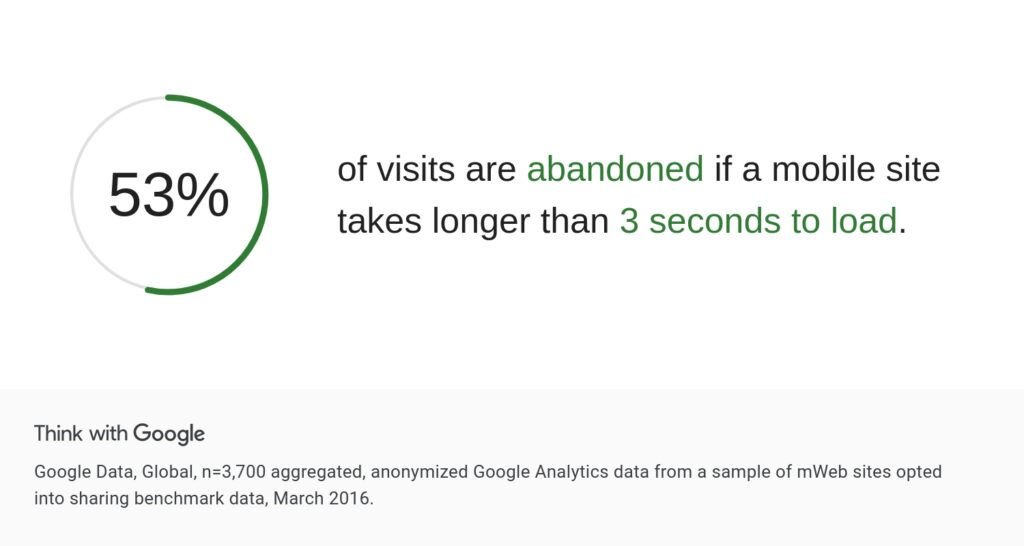
Yet performance optimization is far from simple. Unlike static websites, WordPress is dynamic by nature, constantly generating pages from PHP scripts and database queries. Add WooCommerce into the mix with live shopping carts, personalized checkout flows, and real-time inventory updates, and the challenge becomes even greater. WooCommerce caching becomes critical to maintain speed and reliability. For large stores or content-heavy blogs, the wrong caching strategy can lead to sluggish response times, server overload, and ultimately lost revenue.
This ongoing battle with performance is what makes caching not just a technical detail, but a business-critical necessity. To understand why, let’s break down what caching actually means and the different forms it can take. Choosing the best WordPress cache solution ensures your site is ready for any traffic spike.
Caching Explained: How WordPress/WooCommerce Learns to Be Faster
At its core, caching is about efficiency. Normally, when a visitor requests a page on a WordPress site, the server has to perform a series of expensive operations: running PHP scripts, querying the database, and assembling the page before sending it to the browser. This process can take valuable time, especially under load. WordPress page cache plugins shortcut this process by storing a “ready-made” version of the content. Instead of rebuilding the page for every visitor, the server can deliver the cached copy instantly. The result is lower time to first byte (TTFB), reduced strain on server resources, and a smoother experience for users. If you want to dive deeper into what affects TTFB and how to optimize it, check out our in-depth guide: WordPress Time To First Byte (TTFB) Explained: Causes, Fixes, and Proven Ways to Speed Up Your Site.
Caching is like remembering an answer you’ve already solved. Imagine you spend one minute solving a math problem. If the same question is asked again, you don’t start from scratch: you simply recall the answer instantly. That’s caching: instead of recalculating everything, the system “remembers” the result and delivers it much faster.
Another real-life example: think about your favorite coffee shop. The first time you visit, the barista asks for your exact custom order -maybe a latte with oat milk and an extra shot- and carefully prepares it step by step. But if you come every morning and always order the same thing, they start to remember your preferences and can prepare it much faster. They don’t have to “process” the full order each time because they’ve essentially memorized the steps. That’s exactly how a WordPress page cache plugin works for your site. Selecting the best cache plugin for WooCommerce ensures your dynamic content -such as custom checkout flows or personalized dashboards- loads instantly without risking outdated information.
The Five Pillars of Caching
Caching isn’t one single technique – it’s a whole ecosystem of methods that target different performance bottlenecks in WordPress. In fact, when developers talk about “WordPress caching,” they’re usually referring to full-page caching: the process of storing entire rendered pages for instant delivery. But behind the scenes, several other layers of caching work together to make that speed possible. Below are the main types, explained with both technical detail and practical analogies:
-
Object Caching: Speeding Up Database Calls
Object caching reduces the cost of repeated database queries by storing their results in memory. WordPress relies heavily on database interactions, and WooCommerce intensifies this load with product details, stock checks, and customer session data. By retrieving cached results instead of re-running the same queries, WooCommerce caching improves response times and helps the site handle more users simultaneously. -
Opcode Caching: Making PHP Smarter
Opcode caching operates at the PHP level. Normally, PHP scripts are parsed and compiled into machine-readable code on every request, which creates unnecessary overhead. With opcode caching, the compiled code is stored in memory and reused, eliminating the need to repeat the compilation step. This happens at the server level with tools like OPcache and ensures consistent performance improvements across the entire site. Using the best plugin to speed up WordPress site often involves leveraging opcode caching alongside full-page caching. -
Browser Caching: Faster Loads for Returning Visitors
Browser caching works on the visitor’s device, allowing static assets such as images, CSS, and JavaScript files to be stored locally. Once cached, these files don’t need to be downloaded again on subsequent visits, reducing bandwidth consumption and making page loads feel instantaneous. Browser caching is especially effective for returning visitors and media-heavy sites. WordPress page cache plugins often integrate browser caching to maximize speed for all users. -
CDN Caching: Global Performance at the Edge
Content Delivery Networks (CDNs) extend caching across multiple servers distributed around the world. Instead of serving every request from the origin server, cached versions of content are delivered from the nearest edge location. This reduces latency, improves global site performance, and is essential for businesses with international audiences. A W3 Total Cache alternative or advanced solution like Hermes Cache Pro typically supports full CDN integration for global reach. -
Full-Page Caching: The Real Game-Changer
Full-page caching provides the greatest performance benefits for WordPress and WooCommerce. It stores the entire HTML output of a page and delivers it immediately to visitors, bypassing the need for PHP execution and database queries. This dramatically lowers time to first byte and server load, enabling sites to remain fast even during high-traffic spikes. For WooCommerce, dynamic areas like carts and checkout require careful handling, but when configured properly, full-page caching delivers the most substantial improvements in speed, scalability, and overall user experience.
WordPress Cache ~= Full-Page Cache
When developers and site owners talk about “WordPress caching,” they rarely mean every type of caching simultaneously. In practice, the term has become synonymous with full-page caching, because it provides the largest, most visible performance gains. While object, opcode, browser, and CDN caching all contribute to a site’s speed, these layers are mostly “behind the scenes” optimizations. This is why plugins and hosting providers often highlight “caching” as a key feature: for most sites, full-page caching is the layer that actually reduces load times, improves scalability, and makes a noticeable difference in user experience.
Myth: Caching Breaks Your Site Design
A common concern among WordPress users is that caching might “break” a site’s layout or cause visual glitches. This fear usually comes from bad experiences with poorly configured cache plugins—or from misunderstanding what caching actually does. In reality, caching doesn’t change your design. It simply stores ready-made versions of your web pages so they can be delivered faster to visitors. When implemented correctly, it should improve speed without affecting how your site looks or functions.
The problems appear when caching is mixed with aggressive optimization features like minifying, combining, or deferring scripts without proper configuration. These optimizations can accidentally break layouts if they conflict with your theme or other plugins. That’s why a well-designed cache system focuses on what caching is truly meant for: serving pre-rendered content at high speed, without interfering with your site’s visual integrity.
Why Traditional Caching Breaks on WooCommerce
The biggest challenge with traditional caching is handling dynamic content. WooCommerce cart and checkout pages are personalized for each visitor, making them difficult to cache without risking errors or outdated data. Logged-in users and customer dashboards face the same issue, as they require real-time information. This prevents conventional caching methods from consistently lowering Time to First Byte (TTFB) across an entire store.
Scalability adds another layer of difficulty. Disk-based caches are usually tied to a single data center, which means international customers may experience higher latency and slower response times. For global WooCommerce stores, this leads to inconsistent performance, reduced satisfaction, and potential SEO drawbacks. Persistent object caching with tools like Redis or Memcached can ease database strain by storing query results in memory, but it still does not address the full page generation bottleneck or the need for global delivery. WooCommerce caching solutions must handle both speed and consistency across regions.
Comparison: Leading WordPress/WooCommerce Cache Solutions Performance Benchmarks
Caching plugins and managed WordPress hosts use a variety of strategies to reduce server load and improve page speed. Traditional solutions like W3 Total Cache, WP Rocket, WP Super Cache, and LiteSpeed Cache rely on PHP-level caching combined with object caching (Redis/Memcached in some cases) and browser caching. Managed hosts such as WP Engine alternative providers often use disk-based caching on SSD/HDD to reduce PHP and MySQL load.
While these methods can reduce backend response times to 75–200 milliseconds on small to medium sites, they struggle under high traffic, particularly on WooCommerce stores with complex, dynamic transactions. Hermes Cache Pro is widely regarded as the best WordPress cache for these scenarios, with server-level in-memory full-page caching that maintains consistent speed worldwide.
Hermes Cache Pro vs W3 Total Cache
W3 Total Cache executes caching after PHP processing. Each request still passes through PHP and WordPress before a cached response is delivered, which can create a processing bottleneck on higher-traffic or dynamic WooCommerce pages.
Hermes Cache Pro stores full pages directly in server memory, bypassing PHP. As a result, it generally reduces server response time and TTFB. For sites looking for the best WordPress cache or WordPress page cache plugin, this difference in architecture is a relevant factor when comparing W3 Total Cache alternatives.
Hermes Cache Pro vs WP Rocket
WP Rocket focuses on user-friendly setup but does not include an in-memory full-page cache. Requests still go through PHP before being served, which can affect response times during traffic surges.
Hermes Cache Pro operates at the web server layer, storing pages in memory and reducing processing overhead. This makes it a viable best plugin to speed up WordPress site option for situations where consistent WooCommerce caching is required.
Hermes Cache Pro vs WP Super Cache
WP Super Cache also relies on PHP-level caching. Pages are cached only after WordPress processes them, reducing database load but not eliminating PHP overhead. Server response times can remain higher on traffic-heavy or WooCommerce-intensive sites.
Hermes Cache Pro handles caching at the server level before PHP and WordPress are involved. Pages are delivered directly from memory, maintaining lower response times. This positions it as a practical WordPress page cache plugin and an alternative to consider alongside other traditional caching plugins.
Hermes Cache Pro vs LiteSpeed Cache
LiteSpeed Cache includes server-level caching, but full in-memory caching is available only in enterprise or native web server setups. For most plugin installations, PHP still processes pages, which can reduce raw performance.
Hermes Cache Pro’s architecture stores full pages in memory and can be distributed across multiple edge servers, which may reduce latency for global users. For sites exploring a W3 Total Cache alternative or WP Engine alternative, this approach can provide measurable improvements in TTFB and consistency for WooCommerce caching.
Feature Comparison Table
| Feature / Plugin | Hermes Cache Pro | W3 Total Cache | WP Rocket | WP Super Cache | LiteSpeed Cache |
| Full Page In-Memory Cache | ✅ | ✅ (PHP Layer) | ❌ | ✅ (PHP Layer) | ✅ (Web Server Enterprise Only) |
| WooCommerce Compatibility | ✅ | Partial | ✅ | Partial | ✅ |
| Global CDN Integration | ✅ | Partial | ✅ | Partial | ✅ |
| Server Response Time | <10ms | 75–200ms | 100–250ms | 75–200ms | 50–150ms |
| Memory Usage | Optimized | Medium | Low | Medium | Medium |
| Ease of Setup | No setup needed, built-in | Moderate | Easy | Easy | Moderate |
Note: W3 Total Cache and WP Super Cache operate after PHP execution, limiting performance under high traffic. WP Rocket does not provide in-memory caching. LiteSpeed Cache’s full server-level cache is limited to enterprise or web server setups. Hermes Cache Pro delivers full in-memory caching at the server level, making it a practical best WordPress cache and WordPress page cache plugin option.
What Makes Hermes Cache Pro Different (and Faster)
Hermes Cache Pro delivers the highest level of server response performance for WordPress and WooCommerce sites. Unlike traditional caching solutions that rely on PHP and WordPress to process requests before serving cached content, Hermes operates directly at the web server level, leveraging an in-memory full-page cache; making it the best cache plugin for WooCommerce enterprise-scale stores. Its global distribution and persistent edge caching ensure WooCommerce caching remains fast and reliable even for first-time visitors.This architecture allows pages to be served almost instantly, dramatically reducing server response time. Another key advantage is its global distribution via multiple edge servers. This means cached content can be delivered from the closest server to the visitor, minimizing latency and ensuring consistent performance for users worldwide.
But Hermes goes even further with persistent edge caching: a next-generation approach that keeps cached pages in memory (RAM) across distributed edge locations. Unlike CDN or disk-based caches, which still need to read from storage, Hermes serves pages directly from memory in the closest region. The result is instant delivery and ultra-low latency, even on a visitor’s very first request. Think of it as having Amazon ElastiCache capabilities built into your WordPress environment: enabling true global, in-memory performance without relying on external CDN storage or complex configurations.
The difference in architecture between Hermes Cache Pro and traditional caching methods is significant:
Traditional Full-Page In-Memory Cache:
Web Server → PHP → WordPress → Caching Plugin → Redis / Memcached
Hermes Cache Pro:
Web Server → Hermes Cache Pro In Memory → Direct Response
By bypassing PHP and WordPress entirely, Hermes Cache Pro reduces the processing layers required to serve a page, resulting in almost instant response times even under high traffic conditions. For enterprise-scale WordPress or WooCommerce sites, this design provides both speed and scalability, making Hermes Cache Pro a unique WordPress page cache plugin in the caching ecosystem.
Moving Beyond Traditional Caching
While plugins and host-level disk caches provide a baseline performance improvement, their limitations become clear on large, dynamic, and international WooCommerce sites. They cannot fully support real-time personalized content, and they do not scale efficiently under heavy load or worldwide demand. For stores that aim to reliably reduce TTFB and deliver a seamless experience across regions, the solution lies in next-generation caching technologies built to handle the unique requirements of WooCommerce caching. Using the best cache plugin for WooCommerce ensures these expectations are met.
Why Invest in Advanced Caching?
Let’s face it — free plugins and basic caching methods are fine for small sites, but once your business grows, the cracks begin to show. Slow product pages, checkout delays, and mounting server bills can quietly eat away at revenue and frustrate your customers. This is exactly where Hermes Cache Pro makes a real difference. It’s not just a performance upgrade, it’s a business growth strategy. Using the best cache plugin for WooCommerce can prevent these bottlenecks and maintain a premium user experience.
- Faster Sites, Better Visibility: A faster website doesn’t just feel better — it performs better everywhere that matters. Google rewards speed with higher rankings, and users reward it with more time on site. With Globaliser, even dynamic WooCommerce content loads quickly, meaning your entire store — from product galleries to checkout — stays responsive. That visibility boost alone can translate into a steady stream of new, qualified visitors. Selecting the best plugin to speed up WordPress site is critical for these gains.
- More Conversions, Less Frustration: We all know the pain of a slow checkout: spinning wheels, lagging forms, and lost patience. Each second of delay raises cart abandonment rates. By cutting down Time to First Byte (TTFB) and delivering consistently smooth sessions, Globaliser helps your customers glide through checkout. The result? More completed orders, happier shoppers, and a brand experience that feels premium. WooCommerce caching is essential to ensure this seamless experience.
- Lower Costs, Higher Scalability: Performance isn’t just about user experience — it’s also about cost efficiency. Many companies overpay for extra servers to handle traffic spikes. With Globaliser, your infrastructure works smarter, not harder. By serving content more efficiently, server strain drops dramatically. This means fewer unexpected hosting bills and the ability to scale confidently during peak campaigns, seasonal sales, or sudden viral moments. Implementing a reliable best cache plugin for WooCommerce can maximize these savings.
- ROI That Speaks for Itself: Here’s the best part: the investment pays itself back. Faster sites bring in more visitors, convert more sales, and cost less to maintain. Many businesses see ROI not over years, but in a matter of months. That’s why Globaliser isn’t just a “nice-to-have” tool — it’s a smart, cost-effective choice for enterprises serious about revenue growth and long-term scalability. Choosing the best WordPress cache and a reliable WordPress page cache plugin is a key part of that strategy.
Selecting the Optimal WordPress Cache Strategy for Large and WooCommerce Sites
Choosing the right caching strategy for a large WordPress or WooCommerce site requires careful consideration of several critical factors, including site size, traffic volume, content dynamics, and global reach.
Key Considerations for Caching Solutions
- Site Size and Traffic Volume: Larger sites with high concurrent users benefit most from in-memory caching solutions like Hermes Cache Pro, which can handle heavy loads with minimal latency. Selecting the best plugin to speed up WordPress site ensures you maximize efficiency.
- Content Dynamics: WooCommerce sites with frequent cart interactions and personalized checkout processes need a caching strategy that efficiently manages both cached and uncached content. This highlights the importance of combining full-page caching with backend optimization. WooCommerce caching is the backbone of this approach.
- Global Audience: Sites targeting international customers require globally distributed cache networks to maintain consistent performance worldwide. Without this, users far from the origin server experience slower load times, impacting SEO and conversions. WordPress page cache plugins with CDN support address this challenge – but Hermes Cache Pro goes further, offering persistent in-memory caching at the edge, without relying on CDN cache warming. This ensures globally fast responses from the very first visit.
- Plugin and Theme Compatibility: Some caching solutions can conflict with specific WordPress plugins or themes, especially those generating dynamic content. Compatibility testing is essential to maintain site functionality. Hermes Cache Pro, however, operates at the edge -completely outside the WordPress environment- ensuring zero conflicts with plugins or themes while still delivering full caching benefits.
- Ease of Setup and Maintenance: A caching solution should be simple to configure and manage. Overly complex setups increase the risk of misconfiguration and can negate performance gains. The best WordPress cache balances performance with simplicity.
- Security and Reliability: Server-level caching must integrate seamlessly with security measures to avoid accidentally exposing sensitive or personal data.
- Resource Efficiency: Optimized memory and CPU usage ensures fast responses without overloading the server, particularly important for high-traffic sites.
- Mobile and Device-Specific Optimization: Device-aware caching ensures that mobile users and desktop users both receive an optimal browsing experience. Choosing the best plugin to speed up WordPress site often ensures this optimization is included.
Migration Guides: What Changes with Hermes Cache Pro
Case Study 1: Listelist.com
Listelist is a Turkish list-based articles, listicles, publisher. The site has over 30,000 posts, around million users monthly traffic, 50-100 million web requests monthly. Along with active content writers using the WordPress admin area daily.
Listelist’s WordPress Setup Before Globaliser:
2 Servers Setup:
- 1 Web Server:
- 32 Thread (vCPU) Xeon E5 – Enterprise SSD – 32GB RAM
- Cpanel + LiteSpeed Webserver + Redis Object Cache
- 1 MySQL Database Server:
- 32 Thread (vCPU) Xeon E5 – Enterprise SSD – 32GB RAM

What is This Test / ScreenShot?
This is the result from Google’s PageSpeed testing tool. You can enter any website into the input box to run a test. However, this screenshot displays the results shown above if the website receives some traffic (typically at least 50 visitors per day). It includes real user metrics that Google collects from Google Chrome users visiting the site. The test shows a 28-day average and provides different metrics for mobile and desktop users, as well as for the specific URL tested and the overall site.
So this is real user performance stats collected during their visits to your website.
After Moving to Globaliser Cloud:

Listelist’s WordPress Speed Performance Changes:
| Metrics | Before | After | Drop | Faster |
| TTFB | 1,3s | 0,4s | 69% | 223% |
| LCP | 3,8s | 2,9s | 24% | 31% |
| FCP | 2,1s | 1,2s | 43% | 75% |
| FID | 120ms | 24ms | 80% | 400% |
| INP | 356ms | 217ms | 39% | 64% |
Case Study 2: Permolitboya.com.tr
Permolit Boya, established in Turkey in 1984 by Akçalı Boya, is a leading paint brand known for its innovative products, including Turkey’s first ceiling paint introduced in 1986. In 2017, Akçalı Boya expanded to the UK, founding Akçalı UK and launching the WRX brand. With products available in over 700 retail outlets, WRX has become a recognized name in the UK market.
Permolit Boya’s WordPress Setup Before Globaliser:
1 Server Setup:
- AWS Lightsail 4 vCPU – 16 GB RAM – 320 GB SDD
- Nginx Web Server + Varnish Cache + MySQL DB Server

After Moving to Globaliser Cloud:

Permolit Boya’s WordPress Speed Changes:
| Metrics | Before | After | Drop | Faster |
| TTFB | 1,7s | 0,4s | 76% | 325% |
| LCP | 3,5s | 3s | 14% | 17% |
| FCP | 2,5s | 1,5s | 43% | 66% |
| INP | 188ms | 215ms | -14% | -12% |
Case Study 3: MehmetKazandi.com
MehmetKazandi.com’s WordPress Setup Before Globaliser:
MehmetKazandi.com was running on GoDaddy WordPress Hosting combined with the WP Super Cache plugin.
While WP Super Cache is a decent plugin for basic caching, the overall setup was far from optimal. The site struggled with slow load times, especially for visitors outside Turkey. GoDaddy’s shared hosting environment and limited server locations meant performance was inconsistent and user experience suffered – an unacceptable result for a business aiming for wider reach.
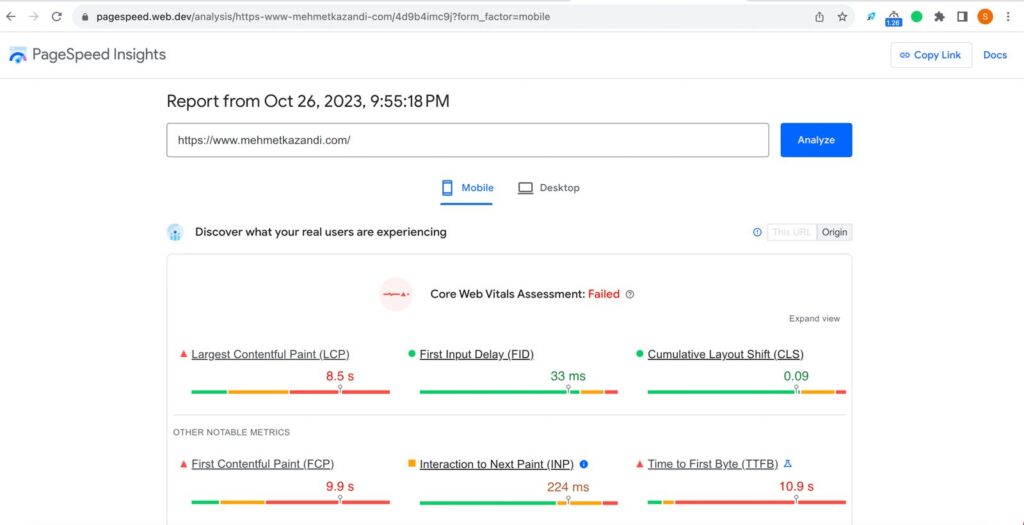
After Moving to Globaliser Cloud:
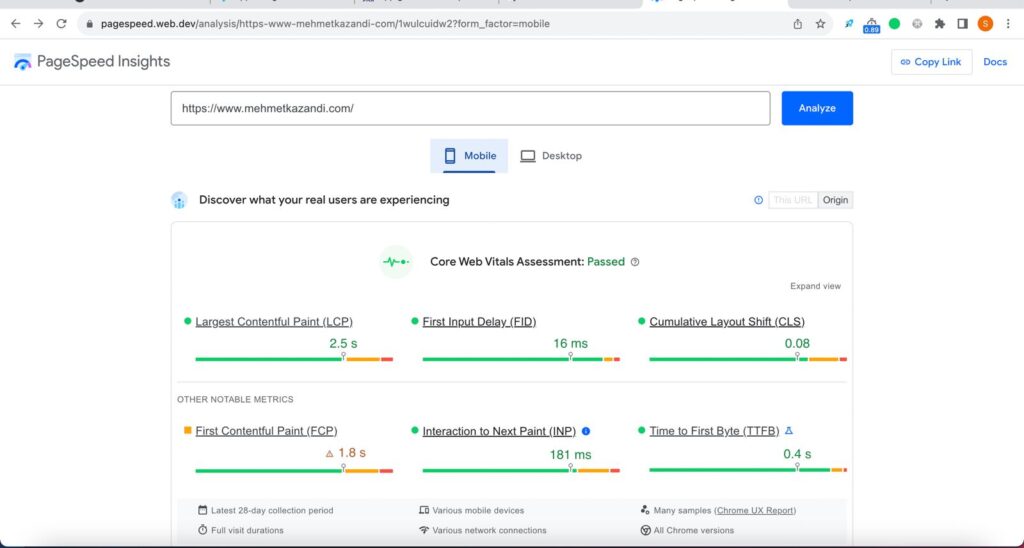
MehmetKazandi.com WordPress Performance After Globaliser Cloud
| Metric | Before | After | Drop % | Faster % |
|---|---|---|---|---|
| TTFB | 10.9s | 0.4s | 96.3% | 2725% |
| LCP | 8.5s | 2.5s | 70.6% | 340% |
| FCP | 9.9s | 1.8s | 81.8% | 550% |
| INP | 224ms | 181ms | 19.2% | 124% |
Globaliser vs Google: 40 Location TTFB Test Results
We ran a global TTFB test using SpeedVitals to compare how Globaliser performs against Google across 40 different locations worldwide. The results are pretty revealing.
Globaliser Test Results
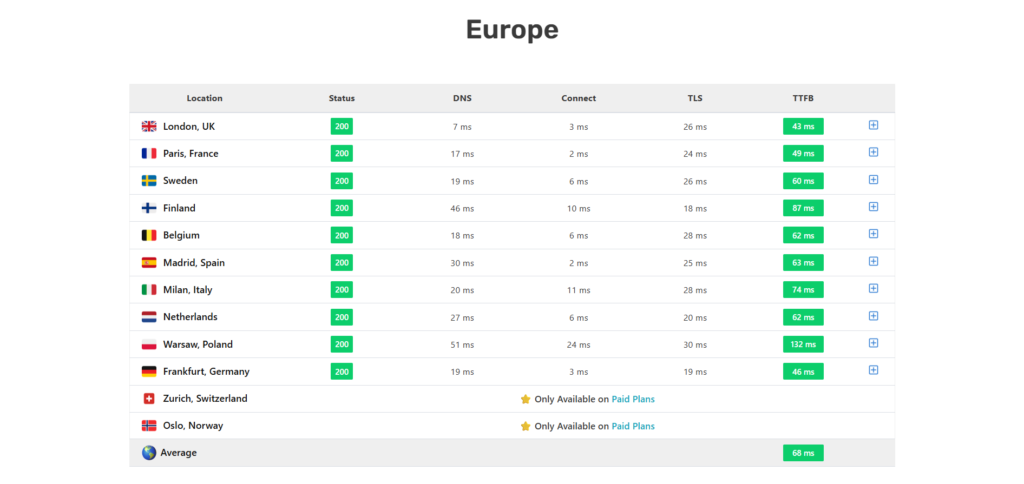
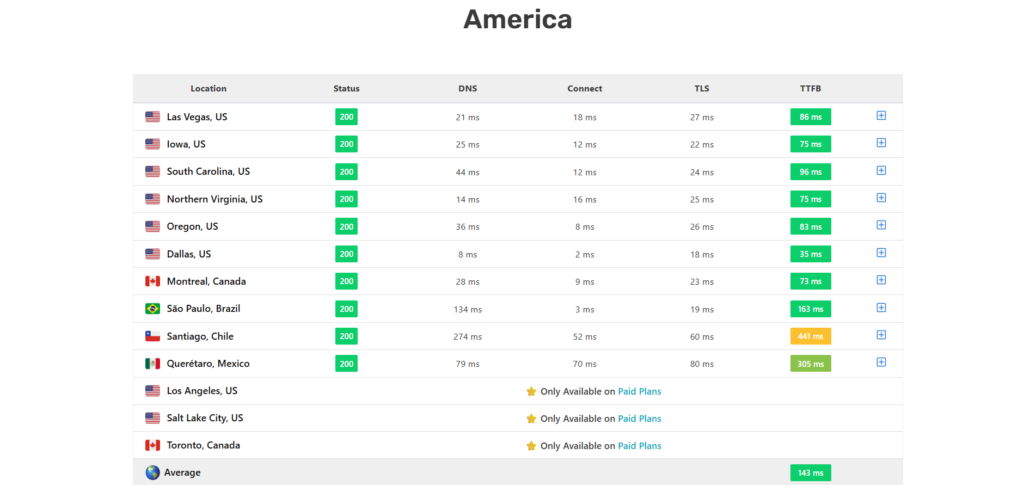
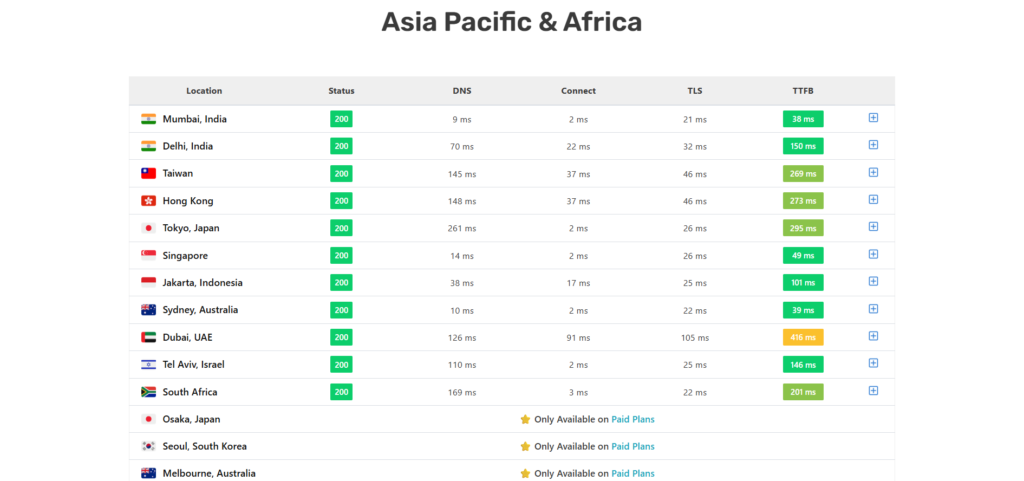
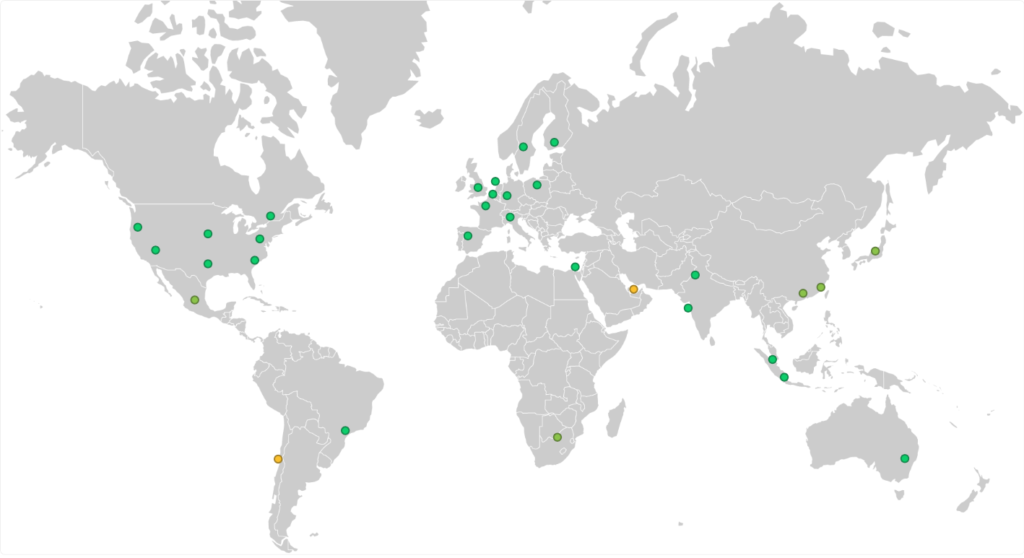
Google Test Results
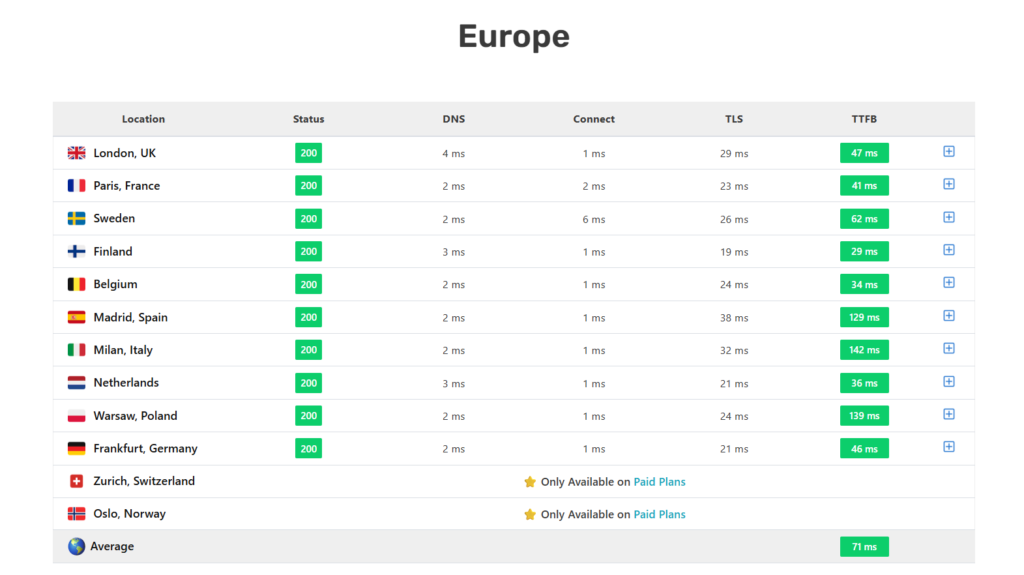
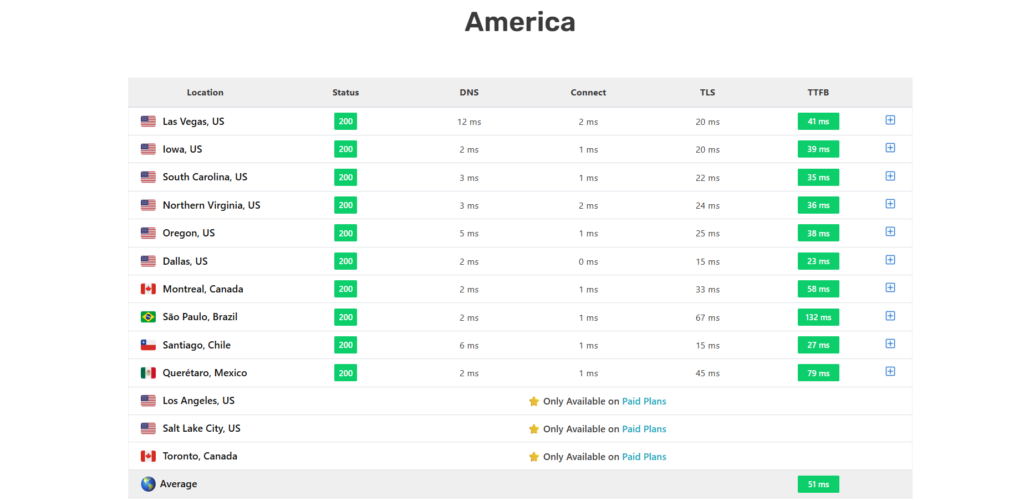
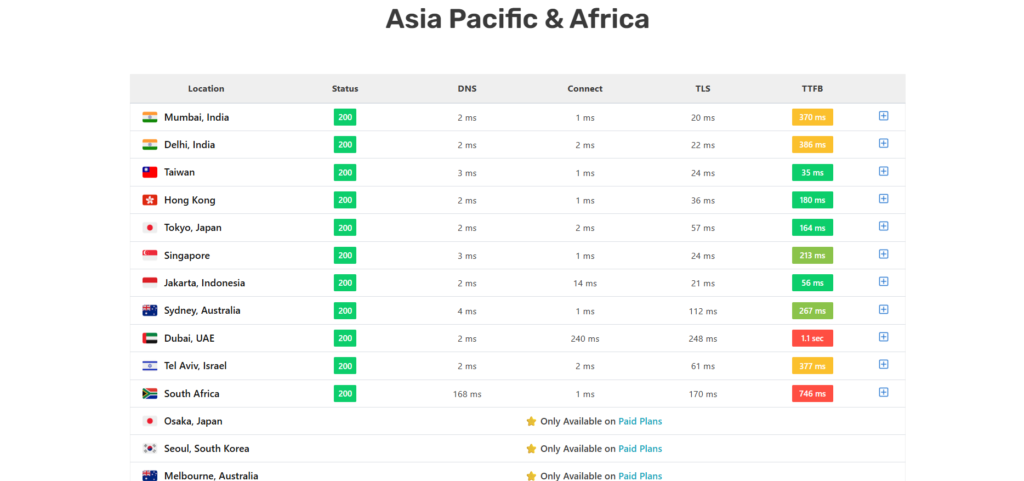
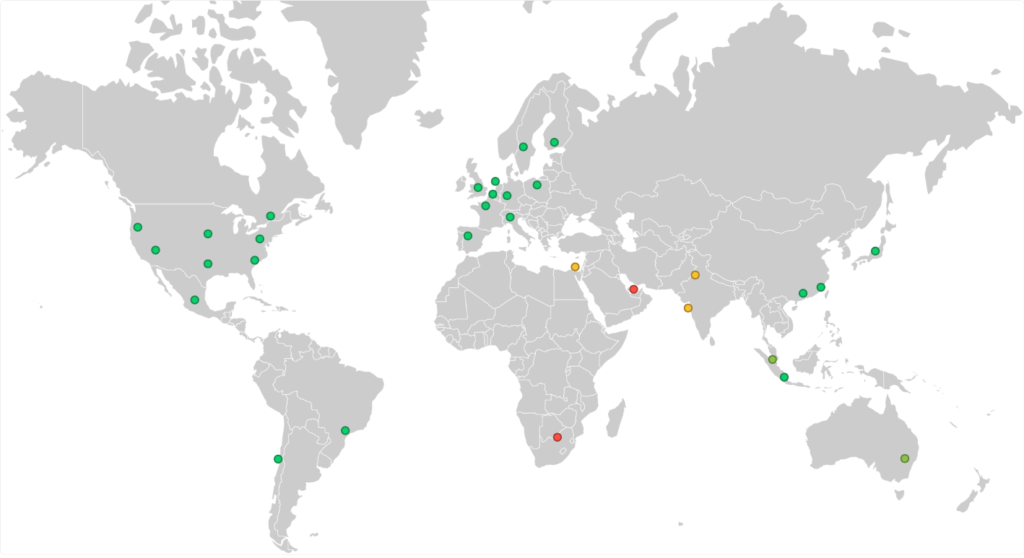
With these tests, it can be seen that Gobaliser actually outperforms Google’s TTFB average in Europe, Asia, and Africa: regions where most hosting stacks tend to slow down significantly. This shows that the network isn’t just optimized for one geography; it’s genuinely balanced across continents. In North America, Google maintains a very slight edge, but the difference is marginal and wouldn’t be noticeable in real user experience. What this test reveals is that Globaliser is not only matching Google’s global performance: it’s leading in key regions. That’s a strong indicator that the infrastructure isn’t just fast locally, it’s globally competitive.
Making the Right Choice for WordPress Caching
Selecting a caching solution isn’t just a technical decision – it directly impacts site speed, user experience, and overall performance. Traditional plugins like W3 Total Cache, WP Rocket, WP Super Cache, and LiteSpeed Cache offer improvements through PHP-level and object caching, but their effectiveness can vary under high traffic or dynamic WooCommerce environments.
Server-level, in-memory solutions such as Hermes Cache Pro provide an alternative approach, reducing processing layers and lowering Time to First Byte (TTFB). For site owners exploring a W3 Total Cache alternative, WP Engine alternative, or searching for dependable WooCommerce caching, understanding these architectural differences is key to making an informed choice.
Ultimately, the best WordPress cache or WordPress page cache plugin depends on your site’s size, traffic patterns, content dynamics, and global reach. Aligning caching strategy with these factors helps ensure faster page loads, smoother user interactions, and more efficient use of server resources – without overcomplicating your infrastructure.
FAQs
Frequently asked questions
Some of the most common questions about caching for WordPress. Can’t find the right answer? Click here to contact us.
What is caching, and why is it important for WordPress sites?
Caching is the process of storing a ready-made version of a web page or resource so it can be delivered faster to visitors. For WordPress sites, caching reduces server load, lowers Time to First Byte (TTFB), improves user experience, and can positively impact SEO and conversion rates.
How does caching affect WooCommerce sites?
WooCommerce caching must handle dynamic content like shopping carts, checkout pages, and personalized user dashboards. Improper caching can cause outdated or incorrect information to display, so it’s important to use solutions designed for WooCommerce.
What is the difference between plugin-level caching and server-level caching?
Plugin-level caching (like WP Rocket or W3 Total Cache) operates within WordPress, often relying on PHP and database queries. Server-level caching (like Hermes Cache Pro) stores pages in memory directly on the web server, bypassing PHP entirely for faster response times.
Can I use multiple caching solutions together?
Yes, but you need to be careful. Combining caching plugins with server-level caching can lead to conflicts or double caching, which might cause display issues or performance problems. Always test configurations in a staging environment first.
Will caching affect my site’s SEO?
Yes. Proper caching can improve page load speed, which is a ranking factor for Google. Faster sites generally result in lower bounce rates and higher user engagement, both of which can positively affect SEO.
Does caching reduce server costs?
Yes. By serving cached content, the number of requests reaching PHP and the database decreases, reducing CPU load and potentially allowing fewer servers to handle the same traffic.
How can I measure the effectiveness of my caching solution?
Use metrics like Time to First Byte (TTFB), server response time, page load time, and user engagement. Tools like GTmetrix or WebPageTest can help benchmark improvements.
Can caching help during sudden traffic spikes or marketing campaigns?
Yes. Full-page caching and server-level caches can serve content directly from memory, reducing backend load and keeping your site fast during traffic surges.
Does caching work with SSL/HTTPS sites?
Yes, but configurations must ensure cached HTTPS responses are correctly served and not mixed with HTTP content, which could cause security warnings or errors.
How often should full-page caches be cleared?
Frequency depends on content changes. Blogs with static posts may refresh daily, whereas WooCommerce stores with frequent inventory or pricing updates may require near-real-time cache invalidation.
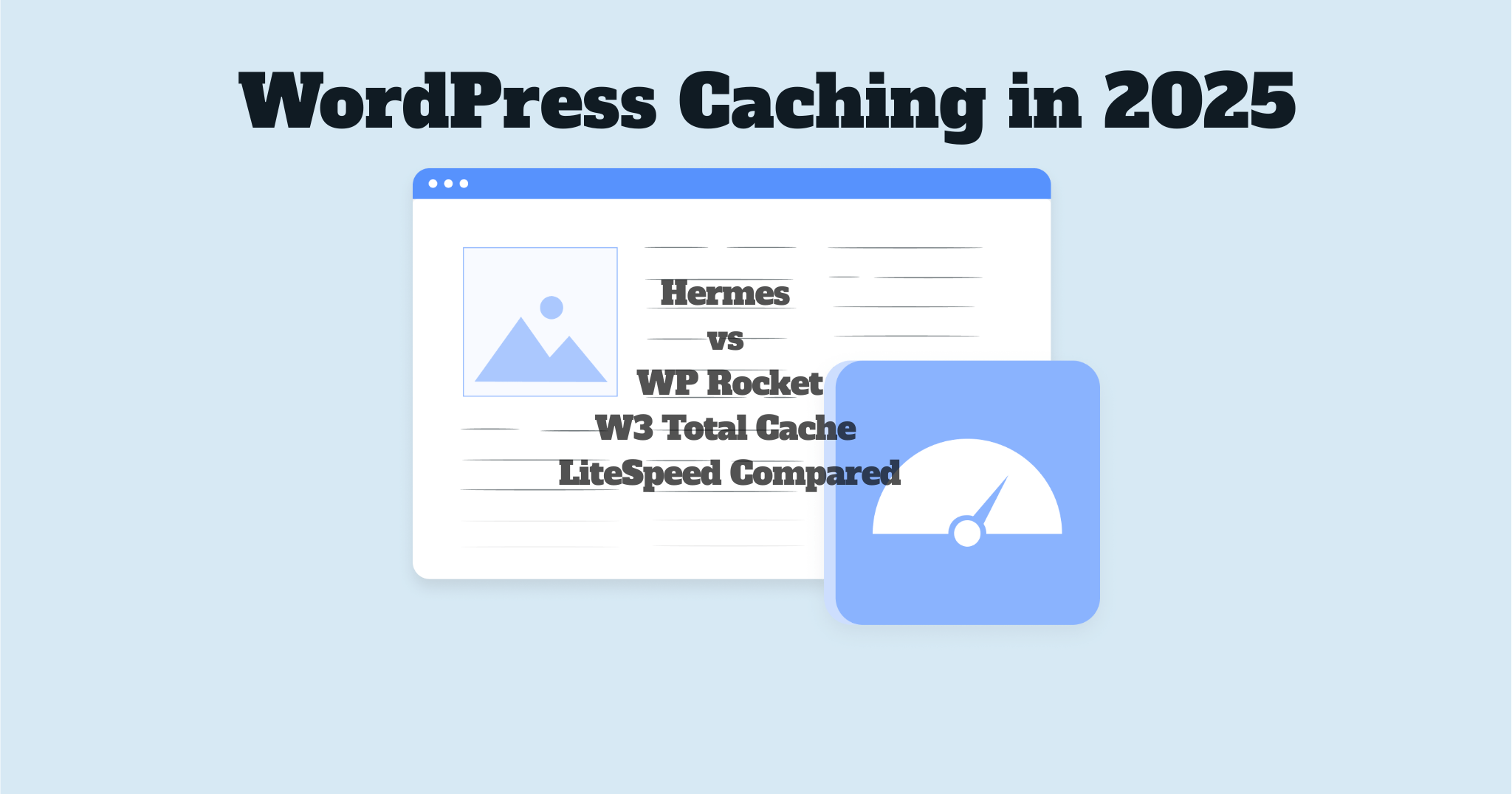
Leave a Reply